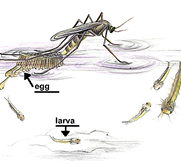Estimación de los parámetros de dos modelos para la dinámica del dengue y su vector en Cali, Colombia
Main Article Content
Keywords
Aedes aegypti, dengue, modelos matemáticos, dinámica poblacional, estimación de parámetros
Resumen
El dengue es una infección viral transmitida por la hembra del mosquito Aedes aegypti que se presenta en todas las regiones tropicales y subtropicales del planeta. En Cali, Colombia, a pesar de los controles que las autoridades de salud dicen estar haciendo, durante el año 2013, se reportaron más de 9.000 casos de dengue, de los cuales algunos han sido graves y otros han llegado a ser letales. Para la transmisión del virus del dengue, los modelos matemáticos que simulan la dinámica de la población infectada, bien sea de humanos, de mosquitos o de ambos, permiten una buena comprensión de la dinámica del virus, por lo que son una excelente herramienta para el seguimiento y control de la enfermedad causada por ellos. Sin embargo, para que esta herramienta sea realmente útil en casos concretos, los modelos deben ser ajustados a las características particulares de la región donde se quieren utilizar. En este artículo, queremos presentar el ajuste de dos modelos matemáticos al área urbana de la ciudad de Cali, Colombia. Inicialmente, con base en el comportamiento natural del mosquito Aedes aegypti en una región como el área de interés, estimamos algunos de los parámetros de los modelos, teniendo en cuenta la literatura existente sobre este tema. Posteriormente, estimamos el resto de parámetros como la solución de mínimos cuadrados que mejor ajusta los resultados de los modelos a los datos de los casos reportados de dengue, según la Secretaria Municipal de Salud de Cali, durante el año 2010.
Descargas
Referencias
S. de Salud Municipal de Cali, “Boletin epidemiológico semanal No. 48,” http://www.valledelcauca.gov.co/salud/descargar.phpid=17079, Diciembre 2015.
B. Alto and S. Juliano, “Temperature effects on the dynamics of Aedes albopictus (Diptera: Culicidae) populations in the laboratory,” Journal of Medical Entomology, vol. 38, pp. 548–556, 2001.
L. Rueda, K. Patel, R. Axtell, and S. R., “Temperature development and survival rates of Culex quinquefasciatus and Aedes aegypti (diptera : Culicidae),” Journal of Medical Entomology, vol. 27, pp. 892–898, 1990.
W. Tun-Lin, T. Burkot, and B. Kay, “Effects of temperature and larval diet on development rates and survival of the dengue vector Aedes aegypti in North Queensland, Australia,” Medical and Veterinary Entomology, vol. 14, no. 1, pp. 31–37, 2000.
H. Yang, M. Macoris, K. Galvani, M. Andrighetti, and D. Wanderley, “Assessing the effects of temperature on the population of Aedes aegypti, the vector of dengue,” Epidemiology & Infection, vol. 137, no. 8, pp. 1188–1202, 2009.
H. Yang, M. da Graça Macoris, K. Galvani, and M. Andrighetti, “Follow up estimation of Aedes aegypti entomological parameters and mathematical modellings,” BioSystems, vol. 103, no. 3, pp. 360–371, 2011.
J. Couret, E. Dotson, and M. Q. Benedict, “Temperature, larval diet, and density effects on development rate and survival of aedes aegypti (diptera: Culicidae),” PLoS One, vol. 9, no. 2, p. e87468, 2014.
C. Marín, A. Muñoz-Loaiza, H. Toro-Zapata, and L. Restrepo-Alape, “Modelado de estrategias para el control químico y biológico del Aedes aegypti,” Matemáticas: Enseñanza Universitaria, vol. 19, no. 1, pp. 63–78, 2011. [Online]. Available: http://www.redalyc.org/pdf/468/46818606006.pdf
R. Anderson and R. May, Infectious diseases of humans: dynamics and control. Oxford university press, 1992.
J. Arias, H. Martinez, L. Sepúlveda, and O. Vasilieva, “Predator-prey model for analysis of Aedes aegypti population dynamics in Cali,” International Journal of Pure and Applied Mathematics, vol. 105, no. 4, pp. 561–597, 2015.
L. Sepúlveda, O. Vasilieva, H. Martínez, and J. Arias, “Ross McDonald: Un modelo para la dinámica del dengue en Cali, Colombia,” Revista de Salud Pública, vol. 17, no. 5, pp. 749–761, 2015.
S. Towers, M. Khan, C. Castillo-Chavez, C. Romero-Vivas, and N. Walkers, “Untangling the underlying causes of seasonality of dengue and chikungunya epidemics in a tropical area: Barranquilla, CO,” Agosto 2015, Conferencia presentada en Second International and Interdisciplinary Worshop on Mathematical Modeling, Ecology, Evolution and Dynamics of Dengue and other Related Diseases, Villa de Leyva, Colombia.
“Base de datos disponible on-line.” [Online]. Available: http://institucional. ideam.gov.co/jsp/index.jsf
J. Suaya, D. Shepard, J. Siqueira, C. Martelli, L. Lum, L. Tan, S. Kongsin, S. Jiamton, F. Garrido, R. Montoya, B. Armien, R. Huy, L. Castillo, M. Caram, B. Sah, R. Sughayyar, K. Tyo, and S. Halstead, “Cost of dengue cases in eight countries in the Americas and Asia: a prospective study,” The American Journal of Tropical Medicine and Hygiene, vol. 80, no. 5, pp. 846–855, 2009.
K. Tomashek, T. Sharp, and H. Margolis, “Dengue,” CDCs Health Information for International Travel: 2014 (Yellow Book), 2014.
A. Costero, J. Edman, G. Clark, and T. Scott, “Life table study of Aedes aegypti (Diptera: Culicidae) in Puerto Rico fed only human blood versus blood plus sugar,” Journal of Medical Entomology, vol. 35, no. 5, pp. 809– 813, 1998.
F. Méndez, M. Barreto, J. Arias, G. Rengifo, J. Muñoz, M. Burbano, and B. Parra, “Human and mosquito infections by dengue viruses during and after epidemics in a dengue–endemic region of colombia,” The American Journal of Tropical Medicine and Hygiene, vol. 74, no. 4, pp. 678–683, 2006.
T. Scott, P. Amerasinghe, A. Morrison, L. Lorenz, G. Clark, D. Strickman, P. Kittayapong, and J. Edman, “Longitudinal studies of Aedes aegypti (Diptera: Culicidae) in Thailand and Puerto rico: blood feeding frequency,” Journal of Medical Entomology, vol. 37, no. 1, pp. 89–101, 2000.

